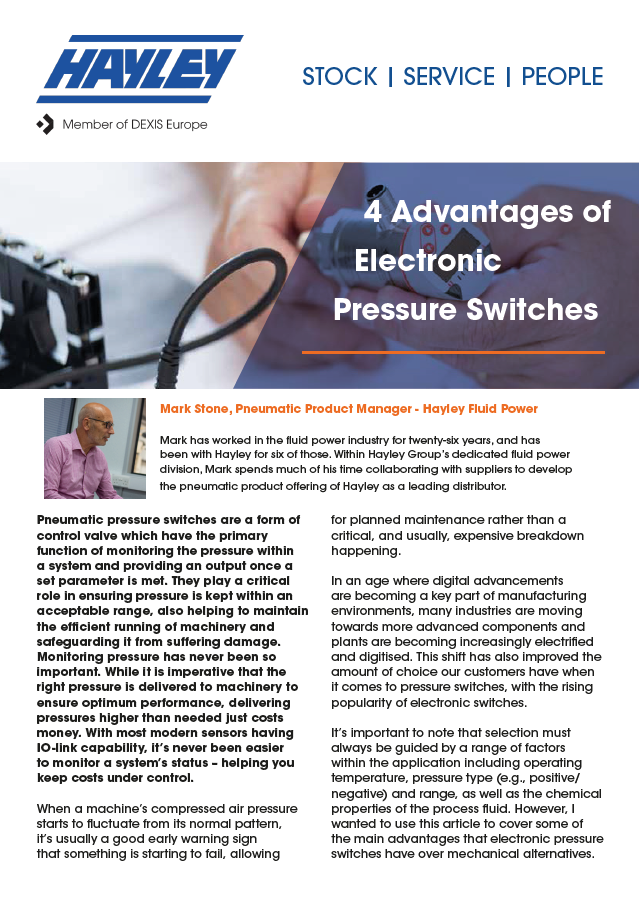Mark Stone, Pneumatic Product Manager - Hayley Fluid Power
Mark has worked in the fluid power industry for twenty-six years and has been with Hayley for six of those. Within Hayley Group’s dedicated fluid power division, Mark spends much of his time collaborating with suppliers to develop the pneumatic product offering of Hayley as a leading distributor.
Pneumatic pressure switches are a form of control valve which have the primary function of monitoring the pressure within a system and providing an output once a set parameter is met. They play a critical role in ensuring pressure is kept within an acceptable range, also helping to maintain the efficient running of machinery and safeguarding it from suffering damage. Monitoring pressure has never been so important. While it is imperative that the right pressure is delivered to machinery to ensure optimum performance, delivering pressures higher than needed just costs money. With most modern sensors having IO-link capability, it’s never been easier to monitor a system’s status – helping you keep costs under control.
When a machine’s compressed air pressure starts to fluctuate from its normal pattern, it’s usually a good early warning sign that something is starting to fail, allowing for planned maintenance rather than a critical, and usually, expensive breakdown happening.
In an age where digital advancements are becoming a key part of manufacturing environments, many industries are moving towards more advanced components and plants are becoming increasingly electrified and digitised. This shift has also improved the amount of choice our customers have when it comes to pressure switches, with the rising popularity of electronic switches.
It’s important to note that selection must always be guided by a range of factors within the application including operating temperature, pressure type (e.g., positive/ negative) and range, as well as the chemical properties of the process fluid. However, I wanted to use this article to cover some of the main advantages that electronic pressure switches have over mechanical alternatives.
1. Easily readable display
Electronic pressure sensors such as the 54D Series from Norgren® usually have an integrated LCD/LED display in a prominent, forward-facing position. This makes taking readings at the machinery side, quick and easy for engineers. Current pressure within the system can, therefore, be obtained efficiently and without requiring the use of any additional instrumentation, with signals converted to readable output within the single unit. The display also makes it possible to program parameters locally, giving users the ability to tweak them as necessary while constantly having visibility on the difference that their actions are having on the devices’ settings.
2. Simple Operation
Electronic pressure switches are blessed with simple operation and functionality. With its small number of buttons (often two), and a display giving visual feedback of all changes, configuration is easily completed locally. A simple combination of button presses enables switch points to be adjusted, saving time and effort devoted to such tasks by engineers. Some mechanical switches have the adjustment screw hidden in difficult-to access places such as underneath the DIN plug connector, making electronic switches far superior in terms of ease of use. Sensors with IO-link capabilities, such as the Norgren® 54D, make parameters even more convenient to reprogram as this task can be done remotely.
3. Improved reliability
Mechanical switches rely on actuation from pressure-sensing elements to operate the switch, and these elements are often the cause of failures within the instrument. In comparison, the lack of moving components in electronic pressure switches makes them more reliable and permits them a longer, trouble-free service life. Fewer small parts within the electronic switches makes them less susceptible to the negative effects of vibration. Contact wear-out is also less of a concern than with traditional, mechanical switches.
Long-term stability and reliability can be achieved with electronic pressure switches when used appropriately, saving your business time and money in carrying-out the maintenance activities required to keep your operations running effectively.
4. Higher accuracy and repeatability
Electronic pressure switches are able to handle thousands of repeated pressure cycles without issue. This ability is inherently due to the high levels of accuracy that they provide and their superior reliability, particularly in applications where vibration is a consideration. The set points are maintained throughout the sensors’ lifetime with any deviation from the parameters not the issue that it is with mechanical switches.
Typical electronic pressure switch accuracies are around ±0.5% of the full-scale (FS) value, while piston-operated mechanical switches often deliver around ±2.0%, giving users peace of mind when it comes to both the effective pressurisation of their pneumatic system and the reliability of readings taken from the instrument.
The many advantages of using electronic pressure switches doesn’t mean that their mechanical predecessors should immediately be replaced. While there are many benefits to utilising electronic switches, their mechanical counterparts remain a good solution for handling less complicated tasks. They are also broadly better suited to handling high voltages and amperages than electronic switches. Electro-mechanical pressure switches, such as the 18D series from Norgren® are also on the market and act as a ‘halfway house’ between the two extremes.
The Hayley branch network is supported by our dedicated Hayley Fluid Power team in providing the optimal solution to customers, whatever their requirements. Contact your local branch to enquire about pressure switches today! Find their details quickly by using our online Branch Finder tool.




